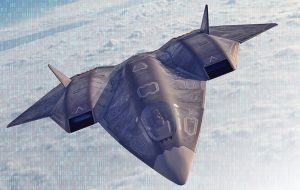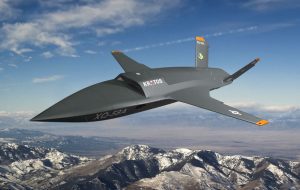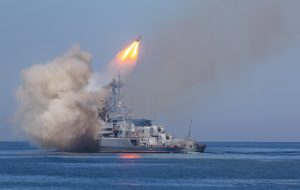Military satellites played a key role in the Second Gulf War, wherein coalition forces used satellites to collect data and to perform battlefield reconnaissance and surveillance missions. These satellites were also used for communication purposes and to pinpoint locations, as a growing number of countries opted for the outer space to foster their military capabilities, to an extent that some countries set up an independent space force.
The current issue examines the multiple military uses of military satellites and the flagship international and regional programs in that regards, as well as scenarios for a potential outer space war.
Military uses of satellites
Satellites can serve a range of military purposes which include:
1
Early warning: Satellites use remote sensing technology for the early detection of trans-continental ballistic missiles and the missiles launched from submarines which can hit targets within minutes. Satellites can also be used to track fleet movement, spy on the enemy’s command and military logistics and activity on air bases in addition to interrupting communications on the battlefield and warning of the enemy’s military attacks. Satellites can also be used to assess the damage resulting from air or nuclear strikes.
In peacetime, satellites are used to observe nuclear sites to ensure respect for the Treaty on the Non-Proliferation of Nuclear Weapons and other disarmament treaties. For instance, Russia’s RORSAT satellite, used for ocean reconnaissance missions is also deployed by the Russian army to track US aircraft carriers in high seas. Moscow is in a position to use the incoming data from the satellite to launch a direct attack on the US multi-billion dollar carrier battle groups.
2
Electronic reconnaissance: Military satellites enable the detection of enemy air defenses, radars and missiles. These include satellites such as the US FERRET, which was meant to carry out electronic reconnaissance tasks and hovers 250 to 400 kilometers above the surface of the planet.
3
Spying on telecommunications: Satellites can also serve intelligence purposes through spying on enemy telecommunications. This type of satellites can be launched in different orbits, unlike military satellites hovering close to earth, whose unique mission is to take images of military sites.
4
Military communications: Satellites enable long-distance encrypted communication between command centers and operational units in the battlefield. These include military satellites, such as VSAT used as a military signal emitter. However, it is still difficult to use laser for communication between satellites or with the ground station because clouds could disrupt and undermine or completely interrupt communication links.
Satellites are also capable of transmitting live footage to the army’s leadership to follow up developments in the battlefield and help them take the right decisions at the right time in order to ensure control of the war zone.
5
Guiding fighter jets and smart missiles: Fighter jets use the US-owned Global Positioning System (GPS), which is composed of 12 satellites, that provide highly accurate geolocation and time information that help locate aircraft positions. In the case of GPS disruptions, fighter jets will find it hard to determine their geolocation and satellite-guided missiles will lose their targeting accuracy.
6
Geospatial intelligence (GEOINT): Satellites can be used for intelligence purposes through the exploitation and the analysis of earth imagery and geospatial information about features and events with reference to space and time. GEOINT, as defined in US code, can perform the following tasks:
Imagery analysis: This stands for the process of analyzing images taken by satellites in order to describe and determine features about the nature of an activity at a specific place on Earth’s surface. Such satellites can take pictures offering precise details on military ground targets. For this purpose, Australia uses AGO satellite, which is responsible for the collection, processing, dissemination and archiving of imagery used by the Australian Defence Force and other government agencies.
Geospatial information and services: A combination of the precise location information and associated attributes of natural and man-made features.
Military programs by major powers
Leading global powers sent to orbit a huge number of military satellites. The following list shows the countries that own the largest chunks:
1
The United States of America: Washington owns 123 military satellites. The US first such satellite was launched in the 1950s under a project known as Weapon System 117L. The initial satellites were used for reconnaissance and imagery purposes. These include the US first military satellites such as Corona, Camyon, Aquacade, Orion, Magnum and Trumpet. The latest satellite to be launched was a Wideband Global SATCOM (WGS-9), which was built by Boeing and was the ninth to be launched within the framework of a project led by the US Air Force including ten satellites dedicated to be used for military communications.
2
Russia: Russia has 74 military satellites. Its military space station program started during the Soviet era in the 1960s under a program known as Almaz. The USSR back then was keen on using space stations instead of satellites. The Almaz program was active from 1973 to 1976 resulting in three stations named Salyut 2, Salyut 3 and Salyut 5. Russia backtracked on establishing space stations in favor of satellites, given that their maintenance cost is much lower. On March 16, 1962, Russia launched its first satellite named Kosmos 1 and on December 2, 2017, it launched its latest military satellite, known as Kosmos 2524, to be used for detecting, tracking, early warning and destroying missiles targeting Russia.
3
China: China has 68 satellites tailored for military purposes. The Chinese space program dates back to the 1950s. Its army operates Yaogan satellites. Yaogan 30D, Yaogan 30E and Yaogan 30F were launched in November 24, 2017. The three satellites are believed to be experimental designed to gather intelligence. These satellites are owned and run by the People’s Liberation Army.
Regional space programs:
Space programs have become part and parcel of industrialization, scientific innovation and economic growth plans. The following paragraphs shed light on the space programs of the UAE and Egypt:
The UAE
The United Arab Emirates launched in 2009 Dubai Sat I, a remote sensing Earth observation satellite. In 2013, it sent to orbit a second satellite Dubai Sat II and in October 2018 it launched KhalifaSat, the third satellite developed by Mohammed Bin Rashid Space Centre in Dubai.
KhalifaSat, which orbits at a lower altitude of 613 kilometers, was 100% built by a team of Emirati engineers. Thus, the UAE became the first Arab nation to fully and independently own satellite manufacturing technology without any foreign dependency. The satellite took high resolution pictures and sent data in line with highest quality standards at a competitive Ground Sampling Distance of 0.7m panchromatic in multiple bands.
In 2014, the UAE space agency saw the light of the day as a federal body created under Federal Law by Decree No. 1 of 2014.The Agency is tasked with developing policies, strategies and plans relating to the space sector that are submitted for the approval of the Council of Ministers. It offers advice and guidance in fields pertaining to national space programs and supports space research and studies both at the theoretical and practical levels. The agency also serves in documenting and spreading information on space and has a mission to train human resources and promote educational activities focusing on space in addition to recruiting national talents in the space industry. In this regards, it offers opportunities, and scientific trips in the field of space in coordination with relevant bodies within the UAE and abroad. Moreover, the agency supports investment projects in the space sector and ensures their economic management.
Within two decades, the UAE launched Thuraya 1 in 2000, Thuraya 2 in 2003 and Thuraya 3 in 2008, DubaiSat-1 in 2009, YahSat 1 in 2011 and YahSat 2 in 2012, DubaiSat 2 in 2013, Nayif-1 in 2017 and YahSat 3 in January 2018, KhalifaSat in October 2018 and MySat 1 in November 2018.
As part of its military space program, the United Arab Emirates planned the launch of two more military satellites Falcon Eye 1 and Falcon Eye 2. The first is an earth observation satellite that the UAE sent into orbit in 2019 using Italy’s Vega launch system from a base in French Guiana. Yet, about two minutes following liftoff, a major dysfunction foiled the mission and the rocket was destroyed in the outer space to avoid its fall on an inhabited area in Guiana. This was the first failure after 14 successful launches of the Vega light-weight rocket since it started service at the Guiana space center in 2012.
The launch of Falcon Eye 1 into orbit aimed both at meeting the needs of the UAE armed forces and at providing pictures for commercial uses. The satellite weighed some 1200 kilograms at takeoff and was intended to be placed into orbit at an altitude of 611 kilometers. The satellite was developed by a consortium bringing together Airbus Defense and Space and Thales Alenia Space.
Afterwards, the UAE planned to launch Falcon Eye 2 in December 2020. The satellite was supposed to be placed by Vega as well but at the end it was delivered by Russia’s Soyuz.
The UAE has spared no effort to develop its military and space capabilities. Last October, His Highness Sheikh Mohammed bin Rashid Al Maktoum, Vice President and Prime Minister of the UAE and Ruler of Dubai announced that the UAE is working on a new satellite project named the MBZ-SAT. The new satellite is designed to offer high resolution satellite imagery as part of a push to promote the country’s scientific and technological advancement. This will be the second satellite to be fully built by a team of Emirati engineers after KhalifaSat which was launched in 2018.
Egypt
The Egyptian space program, put forward by its space research council, was adopted in May 1999. The implementation of the program’s initial phases was led by the National Authority for Remote Sensing and Space until the setting up of the Egyptian Space Agency. The program included building and launching three remote sensing satellites: EgyptSat 1, EgyptSat 2 and DesertSat which is used for exploring water resources in the Egyptian desert.
EgyptSat 1 was built in cooperation with Yuzhnoye Design Bureau in Ukraine. It took off on April 2007 from the Kazakhstan’s Naikonour space port on board a Dnepr rocket. The reception station was set up in Aswan and a command and space operations center was established in New Cairo. The satellite was operational for three years and three month. It exceeded its main service life by three months. Contact with the satellite was lost on July 9, 2010.
The Egyptian space program was halted for many years after the launch of EgyptSat 1. The plan had, however, provided for building a EgyptSat 2 locally starting from 2007 in order to pave the way for its launch in 2012.
Egypt’s space program has suffered from multiple setbacks, particularly the lack of funding. The state has earmarked some five million Egyptian pounds annually, whereas experts insisted that the plan requires a much higher budget. Engineers working on the program have left their jobs to seek better opportunities abroad with much higher salaries compared to those offered by Egypt.
In 2015, Egypt undertook efforts to resurrect its space program. It announced the development of EgyptSat 2 in partnership with China and launched it in early 2017. This satellite is used for imagery and has served environmental purposes in addition to its use in the agricultural sector, urban planning, weather forecast and disaster rescue missions.
In 2019, Egypt launched two 100% locally made satellites without seeking foreign help. These are CubeSat and NARSSCube 1, achieved in July and September respectively. They are part of small CubeSat satellites which add to EgyptSat A launched in February 2019 for geospatial purposes.
In November 2019, Egypt launched Tiba-1, a large satellite used for communication purposes. It weighed 5.6 tons and was designed to help Cairo cut spending on satellite broadcasting services through telecommunication companies in Egypt which it used to hire from foreign countries previously. With this new satellite, Egypt can assert its independent control over the telecommunication network. The satellite can also serve military aims through strengthening the command chain and owning a safe and highly encrypted strategic communications between different units of the armed forces within the country and at the level of the Middle East and North Africa.
Egypt also started building experimental satellites in cooperation with Germany with a view to launching into orbit four medium-size satellites weighing 50 to 70 kilograms for the purpose of scientific research and development projects. In June 2020, reports said Egypt sealed a deal to acquire Italian arms including space military radars.
Space forces by major powers
The surge in conflicts between major powers over the outer space led some to establish an independent space force as a branch of the armed forces. The United States and France have pioneered in this respect.
1
US efforts: US President Donald Trump approved in December 2019 the setting up of a new Pentagon force focused on space warfare, dubbed the US Space Force. This is the first military force to be created by the country in 70 years and is part of the US Air Force. It will receive an initial funding of $40 million in its first year. The force comprises 16,000 Airforce and civilian personnel. It is not intended to put troops into orbit, but will protect US assets – such as the hundreds of satellites used for communication and surveillance.
The US Space Command was created in 1985 to coordinate space operations between different branches of the US military but was disbanded in 2002 after September 11 terrorist attacks. The new version of the US Space Command is the response of Trump administration to the growing military might of Russia and China and their attempts to undermine US space operations mainly through electronic jamming and ground-to-space targeting of US satellites.
The ultimate goal is to set up the US space force as the sixth military branch which will train personnel serving the military in space. Statements by US military officials highlighted fears of Russia or China developing weapons that can target US satellites. General John Raymond, Commander of US Space Command said that the adversaries of the US think that space can be the US military’s Achilles heel and consequently they want to use that to their advantage. “We are the best in the world at space today. Although our supremacy is diminishing. Space will not be an Achilles heel,” he said referring to Washington fears at jamming or destroying its satellites which may paralyze the US army, because it depends primarily on satellites to carry out military operations.
In light of the pivotal role played by US military satellites, some analysts said that if these are attacked by Russia or China that would trigger a major nuclear war. The US army may view the destruction of its satellites as an initial attempt to wage a nuclear war against it. This, in turn, would trigger a US nuclear response against the attacking country. However, other analysts dismiss such a scenario as unrealistic although they do not doubt the key role played by satellites within the US army.
2
French efforts: French President Emmanuel Macron announced on July 13, 2020, the setting up of a space force within the French army as it seeks to develop military satellites that can be armed with machine guns and laser weapons designed to defend civilian and military satellites currently in orbit. This comes amid fears that space could develop into a new frontline between major powers. Military satellites are also facing a new wave of threats, including attempts at being stolen by an enemy force, jamming and cyber-attacks which can make other parties take command of them.
Paris space force comprises small satellites equipped with cameras, radars to detect hostile satellites and sophisticated weapons to destroy them in space. French defense minister, Florence Parly, said that the space force is designed to destroy threats using anti-satellite laser weapons. She said that military satellites performing space surveillance missions will be launched by 2023.
Anti-satellite weapons:
There has never been an incident wherein a state deliberately attacks a satellite of another country, although countries do use satellites to disrupt radio broadcasting. The United States, Russia and China have tested advanced anti-satellite weapons powered by kinetic energy. The United States showed that it can use anti-ballistic missiles to target satellites. Any country that can fire medium-range ballistic missiles carrying nuclear heads is capable of attacking satellites orbiting at low altitudes from Earth.
Anti-satellite weapons do not only have the capacity to paralyze the performance of enemy armies on the battlefield, they also pose a threat to the civilian uses of space. Targeting satellites can deal a hard blow to armies and economies. Some of the countries that have invested in anti-satellite weapons include:
Russia
Moscow undertook largescale investments to develop anti-satellite weapons such as:
A. Ballistic missiles: The Russian army is investing significant time and attention in anti-satellite weapons. The 14A042 Nudol missile is derived from ballistic missile interceptors and can shoot down incoming ballistic missiles, although it has a limited anti-satellite capability. Nudol has completed seven tests to date. The first was undertaken in late 2015. Russia has also tested its anti-satellite system in December 2018, according to a US intelligence report. A Russian anti-satellite missile flew for 17 minutes over 1864 miles to accurately hit its target.
B. Laser weapons: Moscow is believed to have upgraded its Krona Optical Space Surveillance System through equipping it with a technology known as Kalina laser dazzler, meant to blind or damage the optical sensors of enemy spy satellites. Russia also owns Peresvet, another laser weapon, which can destroy satellites orbiting at lower altitudes from Earth.
C. Jamming systems: Russia is investing in satellite jamming systems that disrupt the steam of data between satellites and their customers on the ground. The Global Positioning System (GPS) has been targeted by Russian jamming in and around Russia and in Russian military bases in Syria. Disrupting GPS makes it more difficult for pilots—and self-guided weapons—to quickly reference their own location. Disruptions can take the form of jamming a GPS signal, preventing users from getting any data at all, to spoofing locations and surreptitiously sending fake location data.
D. Space projectiles: The UK and the US accused Russia of testing a weapon-like projectile in space that could be used to target satellites in orbit. The UK said that such actions threaten the peaceful use of space and risk causing debris that could pose a threat to satellites and the space systems on which the world depends. The Outer Space treaty stipulates that the outer space is to be explored by all and purely for peaceful purposes. Under the same treaty, weapons should not be placed in orbit or in space.
E. Fighter jets: In 2009, Alexandre Zelin, Commander of Russia’s air force, said that his country was developing a new version of its Mig-31 fighter which can carry and fire anti-satellite missiles. US intelligence believe that this weapon will be deployed once tests are over in 2022.
The United States
The US army depends extensively on space to achieve its military supremacy on the ground. Some American strategic experts expect that potential adversaries might seek to undermine Washington’s comparative advantages by attacking its satellites. They also recommended that the US army should move to protect space assets by maintaining capacities to destroy satellites used by the enemy for spying, communication, navigation and targeting purposes.
Although this scenario seems unrealistic, some observers put forward the potential worst-case scenario to argue in favor of owning offensive space capabilities. These arguments risk igniting interest for space warfare in other countries. In 2006, Washington launched a new space program to develop anti-satellite weapons building on past interrupted efforts.
The first anti-satellite weapon was made by the US in 1959 after the launch of a ballistic missile from B-47 strategic bomber of the US Air Force to down satellite Explorer VI. This program was known as Bold Orion. The main motive for making this type of weapons at that time was the launch by the USSR of its first satellite, Sputnik, in 1957.
In 1962, Robert Mcnamara, defense secretary in John F Kennedy administration, approved the development of Nike-Zeus missile to target satellites. It was tested in 1963 to down space objects at an altitude of 150 miles. The US government continued developing missiles such as Thor which can hit at an altitude of 400 miles above Earth.
In 1985, US combat fighter F-15 launched missile ASM-135 to destroy a satellite used for sun observation purposes. This was the latest test of an anti-satellite weapon until China launched its first such weapon in 2007. The following year, the US navy used anti-ballistic missile SM-3 to destroy an old reconnaissance satellite.
The US army has anti-satellite weapons as well as bases to intercept missiles in Alaska and Hawaii. The interceptors in both bases were initially developed to target ballistic missiles attacking the US after entering low-Earth orbit.
The Boeing X-37 unmanned spacecraft may also feature in US anti-satellite warfare. Reports mentioned that the spacecraft released three small cubesats into orbit during the OTV-5, a mission that lasted for 780 days. Analysts suggested that the cubesats coild be part of an anti-satellite warfare research program.
China
The Chinese foreign ministry announced in 2007 that China undertook tests in the outer space. This experiment was described by foreign observers and media as a test of an anti-satellite weapon.
China has also launched a rocket in May 2013. Beijing said the rocket served research purposes. Yet, detailed analysis of satellite images provided evidence that the Chinese missile was a test of a new anti-satellite weapon launched from a mobile platform and which can reach an altitude of 36,000 kilometers above the Earth, representing a significant development in Chinese anti-satellite capabilities.
The Worldwide Threat Assessment report released by the US Intelligence Community in 2018 underscored China’s research on guided weapons to be used for anti-satellite purposes. The Defense Intelligence Agency estimated that China developed in 2000 anti-satellite laser weapons launched from a ground base. China is also developing jamming capabilities in order to disrupt data stream between satellites and their ground stations. This is a potent capability that can be used against an enemy deploying forces on long distances such as the United States.
India
The Indian government undertook in 2019 a successful experiment to launch an anti-satellite missile. The mission destroyed an Indian satellite at an altitude of 300 kilometers. The small satellite was launched a month ahead for that purpose. The anti-satellite missile was launched from a base in the eastern Indian coast.
Despite this important Indian experience, India’s capabilities in the field of anti-satellite targeting remains humble compared to others. The targeted satellite during the experiment was orbiting in a low-earth altitude, while other tests hit satellites in higher orbit.
Space warfare challenges:
Space warfare currently involves the disruption of hostile satellites capacity to operate properly leading to confusing the adversary. Present armies depend on satellites for communication, navigation and surveillance. The attacking force can maintain its space assets safe and operational.
Despite the debate over the possibility of the outbreak of a war in space, there are tangible obstacles that make this scenario unlikely, such as:
1
Uncontrollable vast areas: Low-Earth and fixed orbit stretches over an area of about 200 trillion square kilometers, that is 190 times double Earth’s size. This make it very difficult for any country to develop needed capabilities to control such a tremendously vast area.
2
Movement restrictions: Aircrafts, tanks and ships can move in whatever direction within the atmosphere. For satellites, this freedom of movement is not possible due to gravity. They either move in a circular or oval trajectory. Moreover, their maneuverability is limited as they move slowly.
From another perspective, an arms race is expected between major global powers, notably the United States, Russia and China as they all seek to develop anti-satellite weapons. The accusations traded between the US and Russia show that this arms race has already started.
The US Space Force has accused Russia of spreading space projectiles in an orbit close to Earth near a US spy satellite. Although no harm has been done, the US has been complaining for more than a year from Russia’s new series of satellites which can be used to spy on US satellites and as weapons too. For their parts, the Russians argue that the United States developed sophisticated capabilities that can attack the satellite networks of adversaries in wartime.
What fuels this race currently is the lack of laws curbing the proliferation of conventional arms in orbit, whether space to space or space to ground weapons. The Outer Space Treaty of 1967 bans the deployment of arms of mass destructions in space but it did not incriminate the use of conventional arms or double-purpose space technology.
Besides, Russia is upset at the executive order issued by Trump in April 2020 for the mining of the moon, although there is no clear international treaty governing this activity. This has pushed Russia to cooperate with China in order to build a research station on the moon, in a yet another escalation move.
In a nutshell, we can say that future conflicts over space will transcend atmosphere rivalries to attempts at controlling economic resources in planets closer to earth such as the moon, Mars and others, although the required technology is not yet fully in place, it might be ready in the decades to come. In this connection, the launch by the UAE of the Hope Orbiter to Mars, the first such mission in the Arab World, reflects the forward-looking vision of the wise leadership to take part in efforts aiming to explore the outer space and benefit from economic gains that may result, especially since the international space law does not impose clear rules for space exploration. Up to now, it is a first come first served rule.














